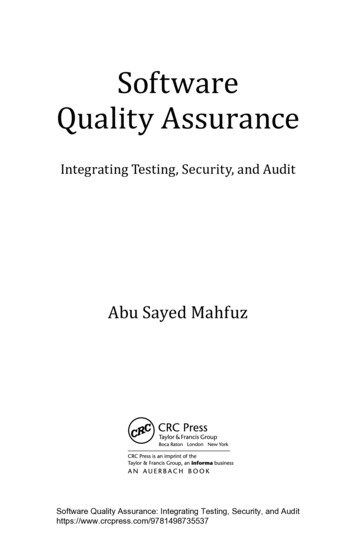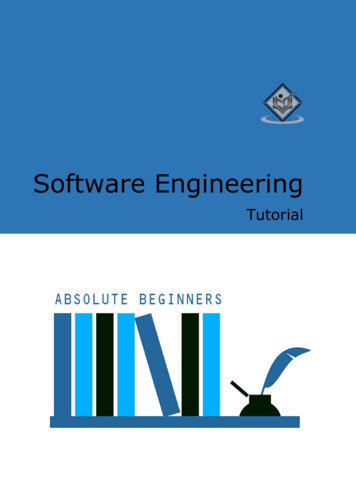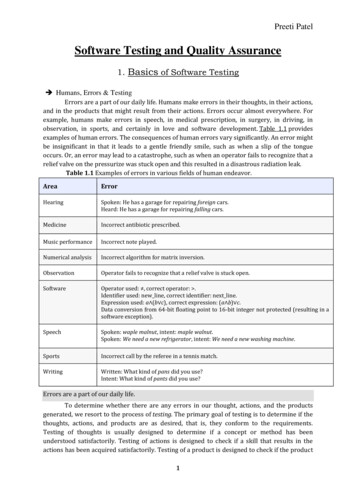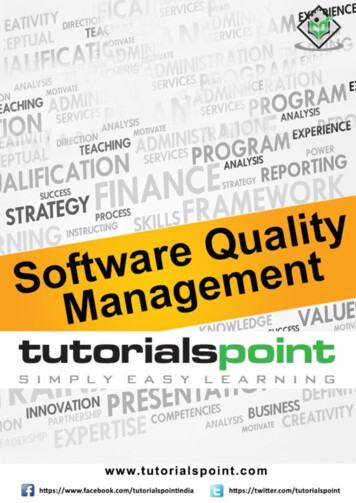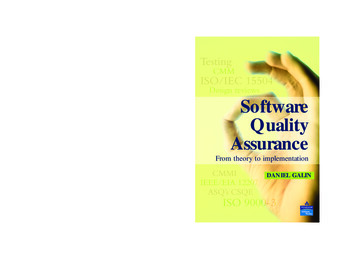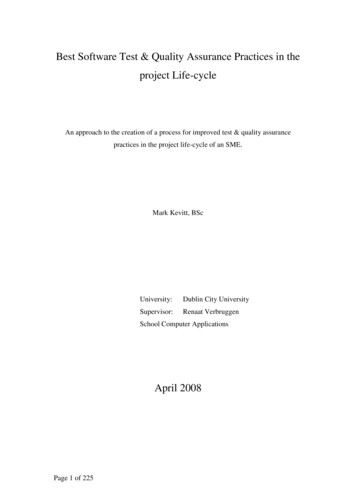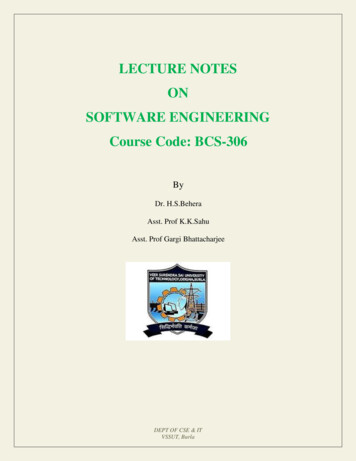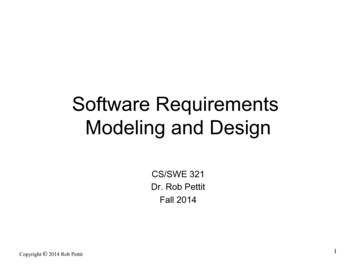
Transcription
Software Quality EngineeringPage 1
ContentsModule-01: Software Quality Engineering Discipline3Module 02: Cost of Software Quality9Module 03: Standards and Models13Module 04: Engineering Process Area20Module 05: Process Management Process Area33Module 06: Software Requirement Engineering vs. Software Quality Engineering41Module 07: Quality Assurance Basics51Module 08: Software Quality Assurance & Defects56Module 09: Software Testing?62Module 10: Test Activities and Management68Page 2
Module-01: Software Quality Engineering DisciplineA. Quality Engineering BasicsWhat is software quality? What are the characteristics of high quality software solutions? Whatdefines quality? These are some of the subjective question in the field of Software QualityEngineering. Modern Software Systems are usually interconnections of multiple underlyingsoftware and due to lack of standardization and varied nature it’s really difficult to definequality. Software Quality Engineering involves complete software development process just toensure that that any agreed-upon processes, standards and procedures are being followed toget desired results and there should be no cherry picking of standardsB. Roles and ResponsibilityPeople may have different expectations related to software quality assurance based on theirroles and responsibility. The stakeholders for software development are divided into two andtheir expectations are as follows:C. ConsumerConsumers of a software product are further categorized into the following: Users are the group which use the services acquired by the customer: The qualityexpectations on the side of users are as follows:o It performs all the functions as specified in the software requirements, whichfits/meets the user’s needs.o Performs all the specified functions correctly over repeated use or over a longperiod of time, or performs its functions reliably. Customer usually acquire the Software and Services: The quality expectations on theside of consumer are as follows:o Basic expectations of the consumer are similar to that of users with additionalconcentration on the cost of the software solution.D. ProducerProducer of the software solutions includes person involved in the development, management,maintenance and service of the software product. It also includes third party software productand organizations. For producers, the expectations are as follows: Their biggest concern is to fulfill their contractual obligations by producing softwareproducts that conform to product specifications. Proper choice of software methodologies, languages, tools, software usability andmodifiability and other factors are closely related to quality for this category ofstakeholders.Page 3
E. Off the Shelf ProductsThese are plug-and-play products and are usually known as Plugins. They are developed andtested independently of Software Solutions. Their main purpose is to provide reusablefunctionality. Off-the-shelf (OTS) software products can be defined as “software product(s)available for any user, at cost or not, and used without the need to conduct developmentactivities”. Proper analysis should be perform while making decision regarding selection OTS asone solution does not fit all.ISO-9126 Quality FrameworkISO-9126 is International Standard for Software Evaluation, it provides hierarchical frameworkfor quality definition, organized into quality characteristics. There are six top-level qualitycharacteristics that are summarized below:F. FunctionalityFunctionality is the essential purpose of any product or service. The functionality characteristicallows drawing conclusions about how well software provides and performs desired functions.The functions are those that satisfy stated or implied needs. The more functions a product has,e.g. a sale order processing system, then the more complicated it becomes to define it'sfunctionality. Continuing with the same example, the sales order system must be able to recordsales, price, quantity, tax, shipping and inventory details. The software product may havemultiple functions, but functionality is expressed as a totality of essential functions that thesoftware product provides.G. ReliabilityThe set of attributes related to the capability of software to maintain its level of performanceunder stated conditions for a stated period of time. The reliability characteristic tells thestakeholders about how effectively and efficiently a software solution maintains the level ofperformance if used under specified/stated conditions. Reliability can be used to evaluate theperformance of whole or part of software and based on that suggest corrective measures toensure continued software performance.H. UsabilityUsability can be defined as the ease to use any function especially from user view-point.Usability refers to the set of attributes of any software solution related to the individualassessment of different function by the stated users. The usability characteristic allows thestakeholders to conclude about how easily the solutions can be learned, understood and used.A good example to understand the concept is the revolutionary switch from Keyboard to touchscreen in 2007, and that makes Steve Jobs quote “Machines can be user Friendly too” a reality.Page 4
I. EfficiencyEfficiency is a set of attributes concerning with the relationship between the level of softwareperformance and the amount of resources used, under stated conditions. This characteristic isconcerned with the system resources (amount of disk space, memory, network etc.) used whenproviding the required functionality. This attribute examines how well the software providesrequired level of performance relative to the amount of resources used. For example, Good UIDesign can take several minute to load due to bad internet connection and it may happen thatHeavy weight UI might take more time to load in presence of good internet connection.J. MaintainabilityMaintainability refers to the set of attributes that bear on the effort needed to make specifiedmodifications. In other words, the ability to identify and repair a fault within a software solutionor any part of it is what the maintainability characteristic tackles. In simple words, themaintainability characteristic allows to conclude about how well software can be maintained.The analyzability, changeability, testability and stability are subcomponents of maintainability.This feature is easier said than done because it is directly related to how well or bad software isdesigned, documented and reviewed periodically.K. PortabilityPortability refers to the set of attributes related to the ability of software to be transferredfrom one environment to another. The portability characteristic tells about how well and easilysoftware can be ported from one environment to another. Presence of functionality is requiredto measure. This attribute also refers to how well the software can adopt to changes in itsrequirements as well. Due to available to multiple platforms these days in 2017 this feature isvery critical for the success because it might happen that one feature might work in one versionof OS but fails to work properly in another version of OS of same platformL. What is Error?Error is a human action that produces an incorrect result and/or the mistakes made byprogrammer is known as an Error. Error is usually some syntax mistakes by developer but it canbe both syntax and semantic error. This could happen because of the following reasons: someconfusion in understanding the requirement of the software; some miscalculation of the values;or/and misinterpretation of any value, etc. Cost of fixing the logical error increases with line ofcodes to be analyzed.M. Example of ErrorExamine the following lines of code:Semantic ErrorCorrected VersionPage 5
?php Amount 100;¡f ( Amount 100)echo “Start calculation”;Calculatetax();elseExit();? ?php Amount 100;¡f ( Amount 100) (Change the logic)echo “Start calculation”;Calculatetax();elseExit();? N. What is Defect?Defect refers to the deviation from customer requirement. Mostly Defects are found in theSoftware after Software is shipped to the customer at production site. Defect is the departureof a quality characteristic from its specified value that results in a product not satisfying itsnormal usage requirements.O. Example of DefectLet’s assume a software solution for online payments. Following table would explain the userexpectation vs. defect.User ExpectationsSoftware DefectThe software will allow me to makeonline payments using debit/credit cardsThe option of selecting the debit cardfor making payments is missing inproduction SoftwareP. What is Bug?Bugs are the errors found before the software is shipped into production. Famously the defectsaccepted by developers are bugs and software is shipped with known bugs. The ugly fact in thesoftware development is that there is nothing like Bug Free Software. Most bugs results frommistakes and errors made in either a program's source code or its design, or in components andoperating systems used by such programs. Bug is rarely traceable by Compiler to its nearestplace.Q. Example of BugJuly 28, 1962 -- Mariner I space probe. A bug in the flight software for the Mariner 1 causes therocket to divert from its intended path on launch. Mission control destroys the rocket over theAtlantic Ocean. The investigation into the accident discovers that a formula written on paper inpencil was improperly transcribed into computer code, causing the computer to miscalculatethe rocket's trajectory.Page 6
R. What is Fault?An incorrect step, process, or data definition in a computer program is known as fault. Faultsare fundamental condition within software that causes certain failure(s) to occur. Faults areknown to be result of errors. In simple terms, Fault is an incorrect step or process due to whichunanticipated result arises.S. Example of FaultLet’s assume that the requirement is to write a program to add two numbers. In order to meetthe requirement, the developer writes the following code:#include stdio.h int main (){int value1, value2, ans;Value1 5;value2 3;ans value1 - value2;printf(”The addition of 5 3 %d.”, ans);return 0;}Due to wrong sign there isdeviation from expected resultT. What is Failure?Failure is a result of fault; failure is inability of theprogram to behave as expected within given performance requirement. According to Laprie “asystem failure occurs when the delivered service no longer complies with the specifications, thelatter being an agreed description of the system's expected function and/or service”. Asmentioned above that failure is the result of fault, the following example would helpunderstand this concept.U. Example of Failure#include stdio.h int main (){int value1, value2, ans;Value1 5;value2 3;ans value1 - value2;Page 7
printf(”The addition of 5 3 %d.”, ans);return 0;}Fault: Due to wrong sign there is deviation from expected resultFailure: Due to Fault there is failure in the output. Instead of adding the two numbers it’ssubtracting the two numbers.V. Defect PreventionRecurring defects are very costly by nature and mere wastage of time and budget and on thesame hand the challenge in any software product development lies in minimizing the number ofdefects. Defect Prevention is strategy to identify root causes of defect and prevent them fromrecurring. Defect prevention is oneof the important activities in anysoftware project. It is QA process toidentify the root causes of defectsand improve the process to avoidintroducing defects, which help toimprove the quality of the softwareproduct.On a macro level defects can beclassified and filtered as depicted inthe figure. But still there is no bugfree product i.e. 99.99% does notmean 100%W. Defect Detection or ReductionDefect Detection and Reduction is process to minimize defects but in a real scenario it is veryunrealistic to expect project or product with 0 bug count. Defect prevention and defectreduction activities directly deal with the competing processes of defect injection and removalduring the software development process (Humphrey, 1995). It is unrealistic to expect thedefect prevention activities to be 100% effective in preventing accidental fault injections.Page 8
Therefore, we need effective techniques to remove as many of the injected faults as possibleunder project constraints.X. Defect Removal or ContainmentDue to nature of Software there are some defects which are produced under rare conditions.Defect Containment aims to reduce the chance of passing of defects from one phase toanother. Due to large size and highly complex software systems, the defect reductiontechniques only reduce the numbers of faults, though, to a very low level but this is notenough. The remaining faults may be triggered under certain and rare conditions. Thus it isnecessary to prevent failures by breaking the causal relations between these faults and theresulting failures, thus “tolerating” these faults, or to contain the failures by reducing theresulting damage.Module 02: Cost of Software QualityQuality is always hard to define and in the case of software quality, it’s more difficult. For anysoftware application, the term quality may have different perception and definition among thedeveloper, users, clients, managers, software quality engineers and other related stakeholders.Definition of quality often becomes even more complicated when quality depends upon thecircumstances/environment in which it is being used. Literature reveals that software has thehighest failure rate in the history of all the products resulting in loss of millions of dollars andthis is one reason that makes quality important.A. Economics of Software Quality EngineeringHigh concerns and challenges in the software quality engineering, one must realize thefollowing facts in order to cope with the quality task: Everything in the process of software development ends up in the user’s satisfaction Satisfaction of the user is dependent on the overall behavior of the system, andsoftware product comes at first The behavior of any software product is defined and comprehended through featuresand quality Features and quality of the software product are defined/determined throughrequirements Any behavior related requirement of the software product can only be actualizedthrough code that execute the behaviorPage 9
Low software quality brings with it some serious economic consequences; therefore, it isimportant to know that only better than-average software quality has tangible economic valuesassociated with it.B. Function-Quality-Cost (FCQ)The discussion on financial ramification of engineering quality into any software product can besummarized through the following statement:In most development projects, functionality and quality ( QA precisely) are natural enemies.Projects with open budgets are very rare, usually the budget is fixed and here the functionalityand quality compete with each other in order to get a bigger share from budget. The FunctionQuality-Cost comes out to be: WhereA & B Level of investmentF Features/FunctionsQ QualityIt is very much clear that increasing feature in a closed-budget project will certainly decreasethe budget share for quality of the product. The following example will elaborate the conceptmore clearly.C. Quality vs. Pre-defined BudgetLet’s take the example of project with fixed budget, say 100,000. Rest of the details would be asfollows:Quality vs. Pre-defined Budget ScenarioTotal BudgetPKR 100,000Total Features4Cost per Feature100,000/4 PKR 25,000Cost BreakupDevelopment Cost of 4 FeaturePKR 80,000Quality Cost of 4 FeaturePKR 20,000In this scenario if the features are increased, there will be less budget for quality maintenanceactivities which is very natural and practical as companies are always under pressure to delivermore ignoring QA and its long term damage. Putting it theoretically, in a fixed priced budgetproject, the quality decreases if the number of features is increased in a closed budgetedproject.Page 10
D. What are Missing Quality Requirements?In a real-time scenario, more budgets mean more quality. This is both theoretically andpractically true. Putting in more money for quality of the software product will result in lowprobability of product failure and may save a lot of financial resources as the high qualityproduct will be immune to threats. For example, a software product with excellent UserInterface (UI) but with no firewall for database security will face more threats. So adding afirewall to ensure Database is secure is more important than spending budget on cosmeticchanges in UI.E. Cost of Missing Quality RequirementsLack of quality in any product can lead to massive losses but when we talk about lack of qualityin software products, we can expect catastrophe. One such scenario occurred when Hackersaccess personal information associated with at least a half billion Yahoo accounts. This incidentwas report in 2016 but occurred sometime in late 2014.What was the ramification? Prior to the announcement of the breach, Verizon negotiated anddecided to purchase Yahoo for 4.8 billion and this deal was to be closed in March 2017. Butlater in February 2017, Verizon and Yahoo announced that the deal will still go forward, butdropping the sale price by 350 million and new offer was 4.48 Billion. On the other side,user’s confidential information including email, credit card details, bank account details andmany others hit the market putting millions of users on stake.F. Cost Analysis Based ApproachMissing Quality in Software Application has direct impact on People and Organizations as seenby the example mentioned in the above lines. Measuring such cost is critical to calculate impactand proceed with damage control otherwise the conditions will turn worst. Along with financialcost, there are other costs as well. According to Eppler and Helfert principles the costs areclassified in two categories: direct and indirect.G. Direct Cost of missing QualityDirect Costs, as the name suggest, are directly linked to the missing quality. The direct costs areeffects that are easily observable/measureable and they occur immediately after anyunfortunate event. Examples includes; financial loss & physical injury and related. In short,direct costs are tangible, visible and measureable.H. Indirect Cost of missing QualityIndirect Costs are invisible cost of missing quality and hence difficult to calculate. It is also,sometime, difficult to realize or identify as they occur after a long time of the incident. Exampleincludes: Loss of market share or reputation, loss of market and shareholders trust andPage 11
investment. Opposed to the direct cost, these are invisible as they may remain hidden forpretty long time, may have long-term impact as well. Scenario of Nokia serves a good example,its CEO said in May-2016 in his farewell speech: “We didn’t do anything wrong but somehowwe Lost”.I. Impact Analysis ApproachMissing quality attributes in software solution can impact both the customers and suppliers.The intensity or the impact of the loss may differ, but this thing is for sure that they’ll bearsome consequences. As in the case of Yahoo, the customers lost their privacy, their personaland business related confidential information. On the other side, Yahoo faced loss of trust; earndisrespect, financial loss, law suits and cost of investigation to find the root cause and others.Moreover, in certain situation customer may face cessation in business operation due to inprocess technical support or any kind of bug in the software solutions. In the worst casescenario, people are exposed to physical injuries to the extent of death. Impact analysisapproach is based on the fact that one must performRoot-cause analysis - Identify problem- Fix it - Keep Going because in fast paced world if youwon’t take appropriate action on right time then failure is inevitableJ. Risk Analysis ApproachRisk analysis approach is essential in determining the cost of missing quality. As in many cases,the time and place of missing quality events is difficult to determine, a better method of costevaluation is risk analysis approach. The risk is defined by its probability (p) and its impact orpotential loss (L). Risk exposure (RE) is the product of the risk probability and its potential loss.The equation could be:() ( ) ( )The probability and loss are directly and strongly related to the level of criticality of thesoftware solution under observation. The different levels of risks are elaborated below.K. Level of RiskThe IEEE Standard for Software Verification and Validation has published the most broadlyknown scale of criticality in the IT domain. The standardized IT system criticality levels are asfollows: Level A: Catastrophico Continuous usage (24 hours per day)o Irreversible environmental damageso Loss of human livesPage 12
o Disastrous economic or social impact Level B: Criticalo Continuous usage (version change interruptions)o Environmental damageso Serious threats to human liveso Permanent injury or severe illnesso Important economic or social impact. Level C: Marginalo Continuous usage with fix interruption periodso Property damageso Minor injury or illnesso Significant economic or social impact. Level D: Negligibleo Time-to-time usageo Low property damageso No risks on human liveso Negligible economic or social impact.Module 03: Standards and ModelsA. Rationale for Quality Management SystemA quality management system is a formalized system to achieve Quality and the absence ofwhich may lead to tragic situation or even product/system failure. A quality managementsystem ensures documentation of Processes, Policies and work flows required to achievedesired standard of quality. One of the famous quality definitions - conformance torequirements - is a very unfortunate one because requirements are sometimes fill with defects,normally known as toxic requirement. It is for sure that conformance to those toxicrequirements is not equivalent to quality. So the software engineering community has a moralobligation to eliminate such requirements.B. Quality Leverage PointsOne such framework to implement quality mindset is the concept of People - Process Technology. It has also been referred to as the “golden triangle”. It reveals that finest Talent isPage 13
unable to perform due to lack of understanding of Processes and talent needs guidance toproduce quality. That is why the Process part of People-Process-Technology triad is often calledthe leg of this triad. It works as a glue to keep together the other two aspects.C. Why Process is needed?Before the discussion of why a process is needed, let’s understand process first. A process is aset of practices performed to achieve a given purpose more importantly practices are uniformand same across organization to perform a specific task. A process serves as an integrationpoint which ensures synergy. Process doesn’t work as a magic stick; it needs time to realize theresults. Process provides a constructive, high-leverage focus on quality. The skills and training ofthe workforce is not always enough and working hard is not the optimal solution. A welldefined and implemented process can provide the means to work smarter, utilizing people andtechnology at optimal level. Technology, by itself, will most likely not be used effectively.Technology, in the context of an appropriate process roadmap, can provide the most benefit.D. Process BenchmarkingProcess benchmarking is a very important part of process improvement initiatives and it offersa variety of benefits including very critical and empirical data related to the organization'scurrent processes and open room for improvements. Benchmarking is comparing existingprocesses and performance metrics to industry’s best processes practices from othercompanies. But this should be kept in mind that there is not good or bad process; internallimitation, circumstances and resources must be evaluated before adopting any externalprocess that seems to be optimal because what works in one situation might not work inothers.Page 14
E. Organization vs. ProcessesOrganizations always need certain steps to achieve certain objectives. Those steps are carefullydrafted and documented as Process along with some other critical elements like responsibilitydefinition, process ownership, and process flow; in order to avoid any confusion. Processes,when implemented and followed correctly, ensure stability in results.There was a time when processes were considered as overhead but with time and thanks tovarious researches, the processes are now considered as major enabler for organizationalsuccess. The focus on change management and organizational culture increased the relevanceof processes in those areas. As mentioned above, there is no silver bullet to bring change inorganization, change is best when it is slow, it requires consistency, vision and right sense ofdirection to bring change in organizations.F. Mature vs. Immature OrganizationMature organizations are system oriented and they ensure stability. They rely on documentedprocesses with clear sense of roles and responsibility at all levels. On the opposite side,immature organizations rely on gut feelings. Even if they have processes in place, they do notfollow or implement them rigorously. Following table identifies major difference betweenmature and immature organizations:Immature OrganizationMature OrganizationProcess improvised during projectInter-group communication and coordinationApproved processes being ignoredWork accomplished according to planReactive, not proactivePractices consistent with processesUnrealistic budget and scheduleProcesses updated as necessaryQuality sacrificed for scheduleWell-defined roles/responsibilitiesNo objective measure of qualityManagement formally commitsG. Process Model Overview of CMMICapability Maturity Model Integration (CMMI) is a collection or a model of best practices insystems, product and software development. CMMI is not a process and it does not tell how todo your work rather it tell what to do to achieve high quality. CMMI is based on the premise ofProcess Management. The CMMI provides a framework for organizing small steps into fivematurity levels that lay successive foundations for continuous process improvement. Thematurity levels have associated process areas. CMMI holds the following beliefs:Page 15
Change should be normal and it must come slowly. Massive changes at once aredoomed to failure Change should come in increments; in various steps. Change must come with future in mind, crisis prevention is better than recovering fromcrisis.H. Behavior of Different Levels of CMMIEach maturity level comes with set of best practices for implementation. When those bestpractices are implemented, each behavior is evaluated and appraised to measure itseffectiveness. The results are compared with Metric (quantitative) based evaluation criteriawhich pre-defined for every behavior. Both the software process and products arequantitatively understood and controlled and the quantitative feedback enables continuousimprovements. Further details of CMMI levels are given below.I. CMMI Maturity Level 1 – InitialAt this level, the organization’s environment is unstable for software development andmaintenance. The processes - if any - well imperfectly defined and are reactive in nature. Theorganization, in overall is, unstable and unpredictable at this stage because the softwareprocess is constantly changed or modified as the work progresses. There is no roadmap forsoftware development i.e., the process is ad hoc. Such organizations do face difficulties inretaining talented resources because of unstructured work and/or uncertainty in theorganization. Let’s examine a scenario:J. Example CMMI Maturity Level 1In a Software House, there are multiple projects in progress and projects can be assigned tosingle or multiple Project Manager, Assume there is new project which is assigned to twoProject Managers, Client asks for what are next steps to proceed?Answer:PM-1: We will do Skype Call for team introductionPM-2: We will send the Project PlanClient: To whom I should believe!!!!!!No responsibilities are defined, no roadmap for development. In other words, no process is inplace whatsoever. There is uncertainty on both client and supplier side with no vision of futureand the development process. Even if the company incorporates good software engineeringpractices, the benefits of those are undermined by ineffective planning.Page 16
K. CMMI Maturity Level 2 – ManagedAt this stage, the policies and related frameworks are established for software developmentprojects. Organizations at this level define a service strategy, create work plans, and monitorand control the work to ensure the service is delivered as planned. Besides work activities andprocesses are managed and ensured that they are planned in accordance with the policy.Organization defines responsibilities to avoid situation mentioned above and also provideadequate resources and training to the workforce so they can smoothly execute the process.This is still not the optimal stage as the process here are often reactive and organizations relyheavily on Heroes and when they are gone, process and performance are gone. Read thefollowing scenario.L. Example CMMI Maturity Level 2A Software House which is Product Based which have around 400 deployments at multipleclient sites. At some point in time, client from Indonesia ask for estimates to develop newmodules in the existing Product. Marketing team of Software House have meeting withDevelopment Team to discuss requirement of new module requested by client.After discussion there was a blocker issue “One of the Software Architect” was absent for lastfew weeks an
Module 02: Cost of Software Quality 9 Module 03: Standards and Models 13 Module 04: Engineering Process Area 20 Module 05: Process Management Process Area 33 Module 06: Software Requirement Engineering vs. Software Quality Engineering 41 Module 07: Quality Assurance Basics 51 Module 08:
